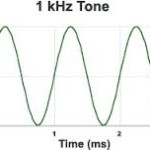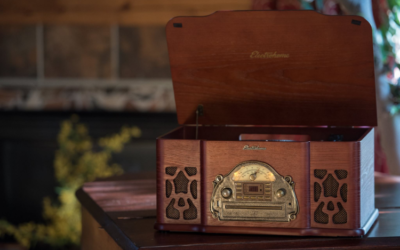Record player are becoming awesome again! In fact they have been awesome for ever, but now more people are starting to realize it. But few people know how that turntable is producing music, so what is the mechanism behind the vinyl sound?
In order to understand the way a record player works, you need to know what sound is. In this article you will read what sound is, how we receive sound and how a record player can produce it.
Sound is just a vibration
Better said, sound is a vibration that reaches our ears. Most of you will have heard at school that sound is a wave that is transported by air or some other substance. In order to refresh your memory, this is how a sound wave looks like:

Horizontal you see the time of the wave and vertical the height of the wave. Both parameters can be changed, when the wave becomes higher; the sound is getting louder. When the wave becomes more compact (more waves per second) the sound is getting higher. This picture is simplified, because sound is 3-dimensional, not 2-dimensional. But you will get the point.
Air is bouncing, not traveling
It is important to understand that the air is not traveling over distance like a thrown rock, it is more passing the wave along like a snooker ball when hitting an other ball. So, each molecule hits the molecule next to it and so on. Like domino stones falling, they hardly move but the effect is traveling:

So, how is this traveling wave becoming a word of song?
How do we hear that wave?
When this vibrating air reaches our ear, our eardrums get hit by the molecules. The vibrating wave is making our eardrum vibrate as well. These vibrations received by neurons, converted into electrical pulses and transported to our brain. Our brain then interprets these electrical signals as sound. What we hear as sound is thus air that makes our eardrums vibrate.

The sound of a record player
So, when sound is nothing more than vibrating air, a record player must be able to make the air vibrate. And yes, that is what a record player does. It makes the air vibrate in the way that is coded into the vinyl record. The grooves in the vinyl and the stylus of the turntable are doing the trick.
- The grooves of the vinyl record
When a record is recorded the sound that needs to be on the record is played/made. The vibrations of which the sound exists are then received by a big membrane or diaphragm. This diaphragm is also starting to vibrate because of the sound waves. The vibrations are than transported to a needle or stylus that is placed on a master record. This record is a bit more soft than a vinyl record. The stylus is vibrating in the same way as the sound made the diaphragm vibrate, when placed on the record the stylus carves in these same vibrations.
The grooves in a record are thus not straight lines, there is a curve in them. The grooves now thus contain the vibration that make up the sound during the recording. In order to play the record, this process needs to be reverse engineered.

Playing a record
When playing the record, the stylus or needle is placed in the grooves. When the record starts to spin, the needle is “reading” the grooves. This makes the stylus vibrating again.
The needle vibrates in the same way the air was vibrating during the recording of the music!
When this signal is amplified, the signal is increased and thereby the sound is made louder. There is thus in theory now electricity or whatsoever needed. In fact,. in this YouTube video a turntable is made from only a needle and an paper horn.




